Deck 3: Cell Structure and Function
سؤال
سؤال
سؤال
سؤال
سؤال
سؤال
سؤال
سؤال
سؤال
سؤال
سؤال
سؤال
سؤال
سؤال
سؤال
سؤال
سؤال
سؤال
سؤال
سؤال
سؤال
سؤال
سؤال
سؤال
سؤال
سؤال
سؤال
سؤال
سؤال
سؤال
سؤال
سؤال
سؤال
سؤال
سؤال
سؤال
سؤال
سؤال
سؤال
سؤال
سؤال
سؤال
سؤال
سؤال
سؤال
سؤال
سؤال
سؤال
سؤال
سؤال
سؤال
سؤال
سؤال
سؤال
سؤال
سؤال
سؤال
سؤال
سؤال
سؤال
سؤال
سؤال
سؤال
سؤال
سؤال
سؤال
سؤال
سؤال
سؤال
سؤال
سؤال
سؤال
سؤال
سؤال
سؤال
سؤال
سؤال
سؤال
سؤال
سؤال

فتح الحزمة
قم بالتسجيل لفتح البطاقات في هذه المجموعة!
Unlock Deck
Unlock Deck
1/126
العب
ملء الشاشة (f)
Deck 3: Cell Structure and Function
1
You are a researcher specializing in cytology,specifically the cell structures of the skeletal muscle that moves the body.The instrument that you would use to see the fine detail within cells would be the
A) MRI scan.
B) light microscope.
C) scanning electron microscope.
D) transmission electron microscope.
E) CT scan.
A) MRI scan.
B) light microscope.
C) scanning electron microscope.
D) transmission electron microscope.
E) CT scan.
D
2
Which of the following is a function of the membrane proteins called channel proteins?
A) They bind to specific extracellular molecules to trigger a cellular change.
B) They permit the passage of ions, bypassing the lipid portion of the cell membrane.
C) They are enzymes.
D) They serve as anchors or stabilizers for the cell membrane.
E) They are used as a source of energy.
A) They bind to specific extracellular molecules to trigger a cellular change.
B) They permit the passage of ions, bypassing the lipid portion of the cell membrane.
C) They are enzymes.
D) They serve as anchors or stabilizers for the cell membrane.
E) They are used as a source of energy.
B
3
Membrane-bound proteins that allow identification of a cell as "self" or "nonself" are called ________ proteins.
A) integral
B) recognition
C) carrier
D) peripheral
E) channel
A) integral
B) recognition
C) carrier
D) peripheral
E) channel
B
4
The concept that each cell of an organism maintains homeostasis is part of our understanding of
A) cell theory.
B) Darwinian theory.
C) the cell cycle.
D) mitotic theory.
E) the theory of differentiation.
A) cell theory.
B) Darwinian theory.
C) the cell cycle.
D) mitotic theory.
E) the theory of differentiation.

فتح الحزمة
افتح القفل للوصول البطاقات البالغ عددها 126 في هذه المجموعة.
فتح الحزمة
k this deck
5
The smallest living things are
A) proteins.
B) organ systems.
C) tissues.
D) organs.
E) cells.
A) proteins.
B) organ systems.
C) tissues.
D) organs.
E) cells.

فتح الحزمة
افتح القفل للوصول البطاقات البالغ عددها 126 في هذه المجموعة.
فتح الحزمة
k this deck
6
Immersion of red blood cells into a(n)________ solution results in lysis of the cell.
A) isotonic
B) hypertonic
C) hypotonic
D) monotonic
E) equilibrated
A) isotonic
B) hypertonic
C) hypotonic
D) monotonic
E) equilibrated

فتح الحزمة
افتح القفل للوصول البطاقات البالغ عددها 126 في هذه المجموعة.
فتح الحزمة
k this deck
7
Crenation occurs when a blood cell is placed in a(n)
A) isotonic solution.
B) pinocytotic solution.
C) hypotonic solution.
D) monotonic solution.
E) hypertonic solution.
A) isotonic solution.
B) pinocytotic solution.
C) hypotonic solution.
D) monotonic solution.
E) hypertonic solution.

فتح الحزمة
افتح القفل للوصول البطاقات البالغ عددها 126 في هذه المجموعة.
فتح الحزمة
k this deck
8
Which of the following terms is used to define the structure that separates the contents of a human cell from its surrounding medium?
A) cell wall
B) cell layer
C) plasma membrane
D) cell boundary
E) nuclear envelope
A) cell wall
B) cell layer
C) plasma membrane
D) cell boundary
E) nuclear envelope

فتح الحزمة
افتح القفل للوصول البطاقات البالغ عددها 126 في هذه المجموعة.
فتح الحزمة
k this deck
9
Looking at a tissue through a microscope,you notice that all of the cells along the free surface of the tissue have microvilli along the free edges of the cells.This would tell you that this tissue has what function?
A) the need to detoxify many chemicals
B) a high metabolic rate
C) phagocytosis
D) motility
E) absorption
A) the need to detoxify many chemicals
B) a high metabolic rate
C) phagocytosis
D) motility
E) absorption

فتح الحزمة
افتح القفل للوصول البطاقات البالغ عددها 126 في هذه المجموعة.
فتح الحزمة
k this deck
10
Structurally,the plasma membrane
A) contains no imbedded proteins.
B) separates the chromatin from the cytoplasm in eukaryotes.
C) contains carbohydrate molecules only.
D) is nonporous.
E) is composed of a bilayer of lipids.
A) contains no imbedded proteins.
B) separates the chromatin from the cytoplasm in eukaryotes.
C) contains carbohydrate molecules only.
D) is nonporous.
E) is composed of a bilayer of lipids.

فتح الحزمة
افتح القفل للوصول البطاقات البالغ عددها 126 في هذه المجموعة.
فتح الحزمة
k this deck
11
The phosphate "head" of a phospholipid is
A) hydrophobic.
B) hydrophilic.
C) polar.
D) nonpolar.
E) both hydrophilic and polar.
A) hydrophobic.
B) hydrophilic.
C) polar.
D) nonpolar.
E) both hydrophilic and polar.

فتح الحزمة
افتح القفل للوصول البطاقات البالغ عددها 126 في هذه المجموعة.
فتح الحزمة
k this deck
12
Opening a bottle of perfume releases perfume molecules from the container,and within a few minutes the perfume can be smelled by a person many feet away from the bottle.This illustrates
A) diffusion.
B) facilitated diffusion.
C) osmosis.
D) filtration.
E) active transport.
A) diffusion.
B) facilitated diffusion.
C) osmosis.
D) filtration.
E) active transport.

فتح الحزمة
افتح القفل للوصول البطاقات البالغ عددها 126 في هذه المجموعة.
فتح الحزمة
k this deck
13
Which of the following is a concept of the cell theory?
A) Cells are the basic structural unit of life.
B) Tissues are the site of control.
C) Organelles are the basic functional unit of life.
D) Cells are produced by meiosis.
E) Cells are immortal.
A) Cells are the basic structural unit of life.
B) Tissues are the site of control.
C) Organelles are the basic functional unit of life.
D) Cells are produced by meiosis.
E) Cells are immortal.

فتح الحزمة
افتح القفل للوصول البطاقات البالغ عددها 126 في هذه المجموعة.
فتح الحزمة
k this deck
14
Flu viruses enter into a prospective host cell (along the respiratory tract)and direct it to produce many copies of the viruses.As those viruses bud off of the infected cell,they take the cell membrane of the host cell with them.How might this kill the host cell?
A) The infected host cell loses the ability to transport materials in and out.
B) The infected cell cannot metabolize.
C) The infected cell cannot make RNA.
D) The infected cell loses the ability to move towards nutrient sources.
E) None of these is correct.
A) The infected host cell loses the ability to transport materials in and out.
B) The infected cell cannot metabolize.
C) The infected cell cannot make RNA.
D) The infected cell loses the ability to move towards nutrient sources.
E) None of these is correct.

فتح الحزمة
افتح القفل للوصول البطاقات البالغ عددها 126 في هذه المجموعة.
فتح الحزمة
k this deck
15
Plasma membranes allow certain molecules to pass,while blocking others.Membranes with this property are called
A) impermeable.
B) freely permeable.
C) selectively permeable.
D) actively permeable.
E) nonpermeable.
A) impermeable.
B) freely permeable.
C) selectively permeable.
D) actively permeable.
E) nonpermeable.

فتح الحزمة
افتح القفل للوصول البطاقات البالغ عددها 126 في هذه المجموعة.
فتح الحزمة
k this deck
16
The movement of water across a membrane from an area of higher water (lower solute)concentration to an area of lower water (higher solute)concentration is known as
A) filtration.
B) active transport.
C) diffusion.
D) facilitated diffusion.
E) osmosis.
A) filtration.
B) active transport.
C) diffusion.
D) facilitated diffusion.
E) osmosis.

فتح الحزمة
افتح القفل للوصول البطاقات البالغ عددها 126 في هذه المجموعة.
فتح الحزمة
k this deck
17
The plasma membrane
A) is a watery gel in which structures are suspended.
B) contains the powerhouse of the cell.
C) is the central government of the cell.
D) regulates the exchange of substances with the environment.
E) carries the cell's hereditary information.
A) is a watery gel in which structures are suspended.
B) contains the powerhouse of the cell.
C) is the central government of the cell.
D) regulates the exchange of substances with the environment.
E) carries the cell's hereditary information.

فتح الحزمة
افتح القفل للوصول البطاقات البالغ عددها 126 في هذه المجموعة.
فتح الحزمة
k this deck
18
Which substances can pass directly through the plasma membrane?
A) carbohydrate-bound
B) water soluble
C) lipid insoluble
D) iron soluble
E) lipid soluble
A) carbohydrate-bound
B) water soluble
C) lipid insoluble
D) iron soluble
E) lipid soluble

فتح الحزمة
افتح القفل للوصول البطاقات البالغ عددها 126 في هذه المجموعة.
فتح الحزمة
k this deck
19
Which of these transport mechanisms do not fit into the rest of the group listed?
A) osmosis
B) diffusion
C) ion pumps
D) passive transport
E) facilitated diffusion
A) osmosis
B) diffusion
C) ion pumps
D) passive transport
E) facilitated diffusion

فتح الحزمة
افتح القفل للوصول البطاقات البالغ عددها 126 في هذه المجموعة.
فتح الحزمة
k this deck
20
The membrane proteins that are sensitive to extracellular materials are called
A) receptor proteins.
B) channel proteins.
C) carrier proteins.
D) anchor proteins.
E) identifier proteins.
A) receptor proteins.
B) channel proteins.
C) carrier proteins.
D) anchor proteins.
E) identifier proteins.

فتح الحزمة
افتح القفل للوصول البطاقات البالغ عددها 126 في هذه المجموعة.
فتح الحزمة
k this deck
21
In which type of solution would equilibrium exist?
A) isotonic
B) hypertonic
C) hypotonic
D) osmotic
E) ionic
A) isotonic
B) hypertonic
C) hypotonic
D) osmotic
E) ionic

فتح الحزمة
افتح القفل للوصول البطاقات البالغ عددها 126 في هذه المجموعة.
فتح الحزمة
k this deck
22
Palytoxin is a very potent toxin from a particular seaweed in Hawaii that locks the carrier proteins of the ion pump system of the cell in an open position.What result would this have on cell function?
A) Sodium cannot enter the cells, and cell metabolism is damaged.
B) The cells cannot utilize glucose.
C) Phagocytosis is inhibited.
D) Diffusion cannot occur.
E) The cell cannot concentrate ions to achieve concentrations necessary for cell function.
A) Sodium cannot enter the cells, and cell metabolism is damaged.
B) The cells cannot utilize glucose.
C) Phagocytosis is inhibited.
D) Diffusion cannot occur.
E) The cell cannot concentrate ions to achieve concentrations necessary for cell function.

فتح الحزمة
افتح القفل للوصول البطاقات البالغ عددها 126 في هذه المجموعة.
فتح الحزمة
k this deck
23
The concentration of ________ determines the osmotic pressure of a solution.
A) solvent molecules
B) water molecules
C) solute molecules
D) channel proteins
E) lipid molecules
A) solvent molecules
B) water molecules
C) solute molecules
D) channel proteins
E) lipid molecules

فتح الحزمة
افتح القفل للوصول البطاقات البالغ عددها 126 في هذه المجموعة.
فتح الحزمة
k this deck
24
The process of binding a specific molecule and then bringing it into the cell in a vesicle is called
A) exocytosis.
B) transcytosis.
C) phagocytosis.
D) receptor-mediated endocytosis.
E) pinocytosis.
A) exocytosis.
B) transcytosis.
C) phagocytosis.
D) receptor-mediated endocytosis.
E) pinocytosis.

فتح الحزمة
افتح القفل للوصول البطاقات البالغ عددها 126 في هذه المجموعة.
فتح الحزمة
k this deck
25
Which of these is an example of carrier-mediated transport that does not require energy input?
A) an ion exchange pump
B) facilitated diffusion
C) endocytosis
D) exocytosis
E) pinocytosis
A) an ion exchange pump
B) facilitated diffusion
C) endocytosis
D) exocytosis
E) pinocytosis

فتح الحزمة
افتح القفل للوصول البطاقات البالغ عددها 126 في هذه المجموعة.
فتح الحزمة
k this deck
26
How does facilitated diffusion differ from simple diffusion?
A) Facilitated diffusion expends no ATP.
B) Facilitated diffusion moves molecules from an area of higher concentration to lower concentration.
C) The rate of solute transport cannot increase indefinitely in facilitated diffusion.
D) The concentration gradient is never eliminated in facilitated diffusion.
E) Facilitated diffusion is independent of carrier molecules.
A) Facilitated diffusion expends no ATP.
B) Facilitated diffusion moves molecules from an area of higher concentration to lower concentration.
C) The rate of solute transport cannot increase indefinitely in facilitated diffusion.
D) The concentration gradient is never eliminated in facilitated diffusion.
E) Facilitated diffusion is independent of carrier molecules.

فتح الحزمة
افتح القفل للوصول البطاقات البالغ عددها 126 في هذه المجموعة.
فتح الحزمة
k this deck
27
A process that requires ATP energy to move a substance independently of its concentration gradient is called
A) active transport.
B) passive transport.
C) facilitated transport.
D) osmosis.
E) diffusion.
A) active transport.
B) passive transport.
C) facilitated transport.
D) osmosis.
E) diffusion.

فتح الحزمة
افتح القفل للوصول البطاقات البالغ عددها 126 في هذه المجموعة.
فتح الحزمة
k this deck
28
A cell must expend energy to accomplish substance movement during
A) diffusion.
B) active transport.
C) passive transport.
D) osmosis.
E) filtration.
A) diffusion.
B) active transport.
C) passive transport.
D) osmosis.
E) filtration.

فتح الحزمة
افتح القفل للوصول البطاقات البالغ عددها 126 في هذه المجموعة.
فتح الحزمة
k this deck
29
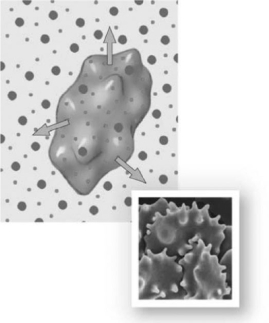 Photo Credit: Steve Gschmeissner / Photo Researchers, Inc.
Photo Credit: Steve Gschmeissner / Photo Researchers, Inc.Figure 3-1 A Red Blood Cell
Use Figure 3-1 to answer the following question:
Choose the correct description for the preceding image.
A) The cell is in a hypotonic saline solution.
B) Osmotic flow does not occur across the plasma membrane of the cell.
C) As the current condition of the cell continues, its plasma membrane may rupture or lyse.
D) The cell is in equilibrium with the solution in that as one water molecule moves out of the cell, another moves in to replace it.
E) As water moves out of the cell, crenation occurs.

فتح الحزمة
افتح القفل للوصول البطاقات البالغ عددها 126 في هذه المجموعة.
فتح الحزمة
k this deck
30
Place these steps in phagocytosis in the correct order. 1.Residue is ejected from the cell.
2)Lysome fuses with vesicle.
3)Cytoplasmic extensions of the cell surround the object being destroyed.
4)A vesicle is formed in the cytoplasm.
5)Digestive enzymes are activated.
A) 3, 4, 5, 2, 1
B) 2, 4, 3, 5, 1
C) 3, 4, 2, 5, 1
D) 1, 4, 5, 2, 3
E) 5, 3, 4, 2, 1
2)Lysome fuses with vesicle.
3)Cytoplasmic extensions of the cell surround the object being destroyed.
4)A vesicle is formed in the cytoplasm.
5)Digestive enzymes are activated.
A) 3, 4, 5, 2, 1
B) 2, 4, 3, 5, 1
C) 3, 4, 2, 5, 1
D) 1, 4, 5, 2, 3
E) 5, 3, 4, 2, 1

فتح الحزمة
افتح القفل للوصول البطاقات البالغ عددها 126 في هذه المجموعة.
فتح الحزمة
k this deck
31
The movement of a molecule from an area of high concentration to an area of low concentration by interacting with a carrier protein is an example of
A) osmosis.
B) active transport.
C) diffusion.
D) facilitated diffusion.
E) filtration.
A) osmosis.
B) active transport.
C) diffusion.
D) facilitated diffusion.
E) filtration.

فتح الحزمة
افتح القفل للوصول البطاقات البالغ عددها 126 في هذه المجموعة.
فتح الحزمة
k this deck
32
Carrier molecules are located within the
A) cytoplasm.
B) plasma membrane.
C) transport vesicles.
D) lipid droplets.
E) chromosomes.
A) cytoplasm.
B) plasma membrane.
C) transport vesicles.
D) lipid droplets.
E) chromosomes.

فتح الحزمة
افتح القفل للوصول البطاقات البالغ عددها 126 في هذه المجموعة.
فتح الحزمة
k this deck
33
A solution that contains a higher solute concentration than the cytoplasm of a cell is called
A) monotonic.
B) hypertonic.
C) isotonic.
D) hypotonic.
E) semitonic.
A) monotonic.
B) hypertonic.
C) isotonic.
D) hypotonic.
E) semitonic.

فتح الحزمة
افتح القفل للوصول البطاقات البالغ عددها 126 في هذه المجموعة.
فتح الحزمة
k this deck
34
Which of the following is true of the sodium-potassium exchange pump?
A) It maintains sodium at equal intracellular and extracellular levels.
B) It is a passive transport process.
C) It moves sodium into the cell and potassium out of the cell.
D) There is one type of carrier protein for sodium and a different type of carrier protein for potassium.
E) It is an example of active transport.
A) It maintains sodium at equal intracellular and extracellular levels.
B) It is a passive transport process.
C) It moves sodium into the cell and potassium out of the cell.
D) There is one type of carrier protein for sodium and a different type of carrier protein for potassium.
E) It is an example of active transport.

فتح الحزمة
افتح القفل للوصول البطاقات البالغ عددها 126 في هذه المجموعة.
فتح الحزمة
k this deck
35
You mix a drop of blood with a drop of an unknown solution and look at the solution under the microscope.The cells look normal to you,so the solution you mixed with the blood would likely be
A) isotonic.
B) hypoosmotic.
C) hypotonic.
D) hypertonic.
E) hyperosmotic.
A) isotonic.
B) hypoosmotic.
C) hypotonic.
D) hypertonic.
E) hyperosmotic.

فتح الحزمة
افتح القفل للوصول البطاقات البالغ عددها 126 في هذه المجموعة.
فتح الحزمة
k this deck
36
Which property of a membrane determines which molecules may enter or leave?
A) differentiation
B) growth
C) structural integration
D) permeability
E) cellular activation
A) differentiation
B) growth
C) structural integration
D) permeability
E) cellular activation

فتح الحزمة
افتح القفل للوصول البطاقات البالغ عددها 126 في هذه المجموعة.
فتح الحزمة
k this deck
37
 Photo Credit: Steve Gschmeissner / Photo Researchers, Inc.
Photo Credit: Steve Gschmeissner / Photo Researchers, Inc.Figure 3-1 A Red Blood Cell
Use Figure 3-1 to answer the following question:
The release of intracellular materials by a vesicle at the cell surface is called
A) osmosis.
B) active transport.
C) exocytosis.
D) endocytosis.
E) an ion exchange pump.

فتح الحزمة
افتح القفل للوصول البطاقات البالغ عددها 126 في هذه المجموعة.
فتح الحزمة
k this deck
38
A mechanism in which two substances move in opposite directions across the cell membrane is called
A) facilitated diffusion.
B) vesicular transport.
C) endocytosis.
D) countertransport.
E) osmosis.
A) facilitated diffusion.
B) vesicular transport.
C) endocytosis.
D) countertransport.
E) osmosis.

فتح الحزمة
افتح القفل للوصول البطاقات البالغ عددها 126 في هذه المجموعة.
فتح الحزمة
k this deck
39
Two solutions are separated by a semipermeable membrane with the same properties as a cell membrane.Solution A is 5 percent glucose and solution B is 10 percent glucose.Under these circumstances,
A) water will move from solution A to solution B.
B) water will move from solution B to solution A.
C) glucose will move from solution A to solution B.
D) glucose will move from solution B to solution A.
E) at equilibrium the concentration of glucose will be higher in solution B.
A) water will move from solution A to solution B.
B) water will move from solution B to solution A.
C) glucose will move from solution A to solution B.
D) glucose will move from solution B to solution A.
E) at equilibrium the concentration of glucose will be higher in solution B.

فتح الحزمة
افتح القفل للوصول البطاقات البالغ عددها 126 في هذه المجموعة.
فتح الحزمة
k this deck
40
Alcohol and fatty acids enter cells via
A) anchor proteins.
B) receptor proteins.
C) lipid channels.
D) diffusion.
E) endocytosis.
A) anchor proteins.
B) receptor proteins.
C) lipid channels.
D) diffusion.
E) endocytosis.

فتح الحزمة
افتح القفل للوصول البطاقات البالغ عددها 126 في هذه المجموعة.
فتح الحزمة
k this deck
41
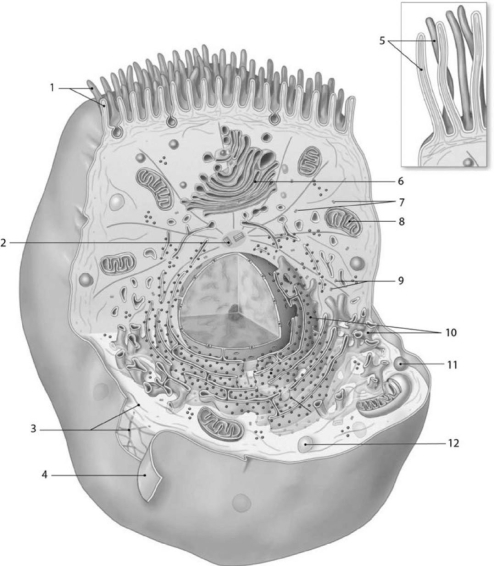 Figure 3-3 Anatomy of a Model Cell
Figure 3-3 Anatomy of a Model CellUse Figure 3-3 to answer the following questions:
Which of the following labeled structures is essential for movement of the chromosomes during cell division?
A) 5
B) 3
C) 2
D) 6
E) 1

فتح الحزمة
افتح القفل للوصول البطاقات البالغ عددها 126 في هذه المجموعة.
فتح الحزمة
k this deck
42
 Figure 3-3 Anatomy of a Model Cell
Figure 3-3 Anatomy of a Model CellUse Figure 3-3 to answer the following questions:
Which of the labeled cellular structures are involved in metabolic activity that produces energy for the cell?
A) 10
B) 6
C) 5
D) 11
E) 8

فتح الحزمة
افتح القفل للوصول البطاقات البالغ عددها 126 في هذه المجموعة.
فتح الحزمة
k this deck
43
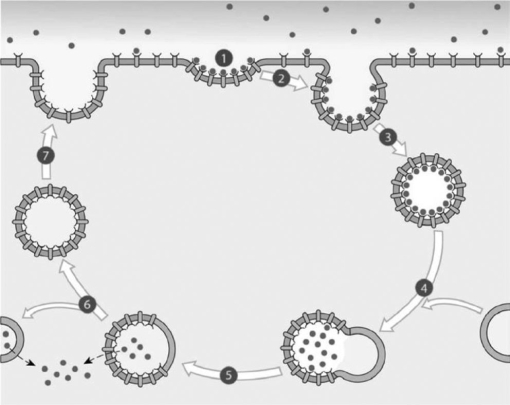 Figure 3-2 A Process
Figure 3-2 A ProcessUse Figure 3-2 to answer the following questions:
Identify the primary process that is featured in the preceding image.
A) receptor-mediated endocytosis
B) pinocytosis
C) sodium-potassium exchange
D) phagocytosis
E) facilitated diffusion

فتح الحزمة
افتح القفل للوصول البطاقات البالغ عددها 126 في هذه المجموعة.
فتح الحزمة
k this deck
44
The cell seen in the preceding diagram could be
A) undergoing cell respiration.
B) replicating its DNA.
C) phagocytosing cell debris.
D) modifying and releasing a cellular protein.
E) performing active transport.
A) undergoing cell respiration.
B) replicating its DNA.
C) phagocytosing cell debris.
D) modifying and releasing a cellular protein.
E) performing active transport.

فتح الحزمة
افتح القفل للوصول البطاقات البالغ عددها 126 في هذه المجموعة.
فتح الحزمة
k this deck
45
Which of the following is an example of membranous organelles?
A) lysosomes
B) cilia
C) centrioles
D) ribosomes
E) cytoskeleton
A) lysosomes
B) cilia
C) centrioles
D) ribosomes
E) cytoskeleton

فتح الحزمة
افتح القفل للوصول البطاقات البالغ عددها 126 في هذه المجموعة.
فتح الحزمة
k this deck
46
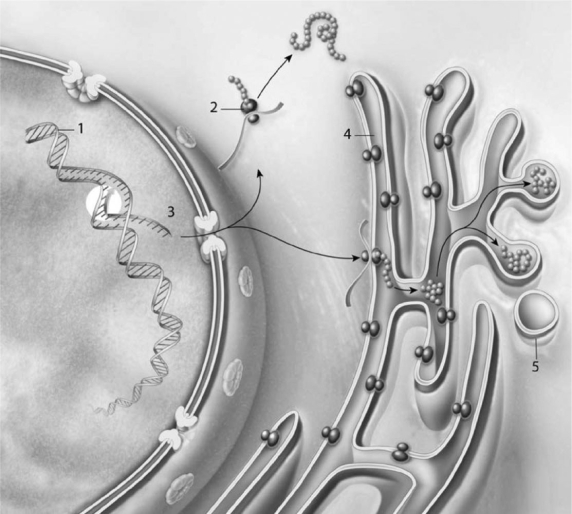 Figure 3-5 Protein Synthesis
Figure 3-5 Protein SynthesisUse Figure 3-5 to answer the following question:
Structure #4 is where the protein
A) folds into its 3D shape and is possibly modified.
B) is converted into mRNA.
C) is released out of the cell.
D) combined with DNA to form nucleoproteins.
E) is endocytosed.

فتح الحزمة
افتح القفل للوصول البطاقات البالغ عددها 126 في هذه المجموعة.
فتح الحزمة
k this deck
47
What is the function of the structure labeled #12?
A) intracellular removal of damaged organelles or pathogens
B) breakdown and recycling of damaged or abnormal intracellular proteins
C) protein synthesis
D) movement of material over cell surface
E) catabolism of fats and other organic compounds
A) intracellular removal of damaged organelles or pathogens
B) breakdown and recycling of damaged or abnormal intracellular proteins
C) protein synthesis
D) movement of material over cell surface
E) catabolism of fats and other organic compounds

فتح الحزمة
افتح القفل للوصول البطاقات البالغ عددها 126 في هذه المجموعة.
فتح الحزمة
k this deck
48
The peroxisome
A) produces proteins.
B) is responsible for the formation of microtubules.
C) functions in macromolecular biosynthesis.
D) breaks down fatty acids and other organic compounds.
E) is responsible for cellular transport through the Golgi apparatus.
A) produces proteins.
B) is responsible for the formation of microtubules.
C) functions in macromolecular biosynthesis.
D) breaks down fatty acids and other organic compounds.
E) is responsible for cellular transport through the Golgi apparatus.

فتح الحزمة
افتح القفل للوصول البطاقات البالغ عددها 126 في هذه المجموعة.
فتح الحزمة
k this deck
49
There are chemicals that bind to microfilaments and block the elongation of actin in a cell.This would damage
A) cell metabolism.
B) protein synthesis.
C) DNA replication.
D) muscle contraction.
E) ATP production.
A) cell metabolism.
B) protein synthesis.
C) DNA replication.
D) muscle contraction.
E) ATP production.

فتح الحزمة
افتح القفل للوصول البطاقات البالغ عددها 126 في هذه المجموعة.
فتح الحزمة
k this deck
50
Paired structures made of microtubules that are perpendicular to each other are called the
A) chromosomes.
B) ligand receptors.
C) centromeres.
D) nucleoli.
E) centrioles.
A) chromosomes.
B) ligand receptors.
C) centromeres.
D) nucleoli.
E) centrioles.

فتح الحزمة
افتح القفل للوصول البطاقات البالغ عددها 126 في هذه المجموعة.
فتح الحزمة
k this deck
51
Which of the following consists of a set of flattened membranous disks?
A) rough ER
B) smooth ER
C) mitochondria
D) nucleoli
E) Golgi apparatus
A) rough ER
B) smooth ER
C) mitochondria
D) nucleoli
E) Golgi apparatus

فتح الحزمة
افتح القفل للوصول البطاقات البالغ عددها 126 في هذه المجموعة.
فتح الحزمة
k this deck
52
Protein production is a function of the
A) microtubules.
B) mitochondria.
C) rough ER.
D) ribosomes.
E) Golgi apparatus.
A) microtubules.
B) mitochondria.
C) rough ER.
D) ribosomes.
E) Golgi apparatus.

فتح الحزمة
افتح القفل للوصول البطاقات البالغ عددها 126 في هذه المجموعة.
فتح الحزمة
k this deck
53
 Figure 3-3 Anatomy of a Model Cell
Figure 3-3 Anatomy of a Model CellUse Figure 3-3 to answer the following questions:
Structure #1 represents the
A) ribosomes.
B) microvilli.
C) cilia.
D) Golgi apparatus.
E) cytoskeleton.

فتح الحزمة
افتح القفل للوصول البطاقات البالغ عددها 126 في هذه المجموعة.
فتح الحزمة
k this deck
54
 Figure 3-3 Anatomy of a Model Cell
Figure 3-3 Anatomy of a Model CellUse Figure 3-3 to answer the following questions:
Which of the following functions in the synthesis of secretory products,as well as intracellular storage and transport?
A) 9
B) 10
C) 4
D) 11
E) 6

فتح الحزمة
افتح القفل للوصول البطاقات البالغ عددها 126 في هذه المجموعة.
فتح الحزمة
k this deck
55
________ processes move substances across a membrane regardless of concentration gradients.
A) Active transport
B) Filtration
C) Passive transport
D) Diffusion
E) Osmotic
A) Active transport
B) Filtration
C) Passive transport
D) Diffusion
E) Osmotic

فتح الحزمة
افتح القفل للوصول البطاقات البالغ عددها 126 في هذه المجموعة.
فتح الحزمة
k this deck
56
The folds of the internal membrane within mitochondria are called
A) cristae.
B) cytosol.
C) cisternae.
D) matrix.
E) histones.
A) cristae.
B) cytosol.
C) cisternae.
D) matrix.
E) histones.

فتح الحزمة
افتح القفل للوصول البطاقات البالغ عددها 126 في هذه المجموعة.
فتح الحزمة
k this deck
57
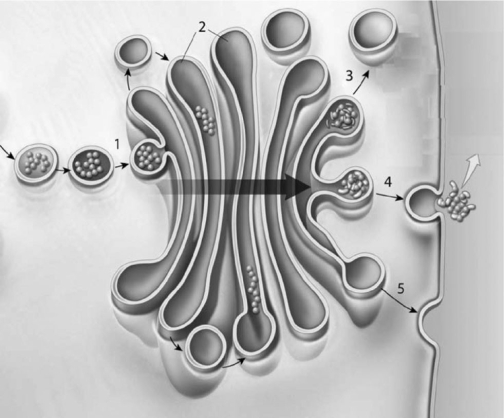 Figure 3-4 Protein Synthesis
Figure 3-4 Protein SynthesisUse Figure 3-4 to answer the following questions:
Identify the organelle shown in the figure,which is described as stacks of flattened membranes containing chambers.
A) flagellum
B) RER
C) mitochondrion
D) Golgi apparatus
E) SER

فتح الحزمة
افتح القفل للوصول البطاقات البالغ عددها 126 في هذه المجموعة.
فتح الحزمة
k this deck
58
Using the preceding image,determine the correct sequence of events in the primary process,which begins when target molecules (ligands)bind to receptors in the plasma membrane. 1.Target molecules are removed and absorbed into the cytoplasm.
2)The membrane containing the receptor molecules detaches from the lysosome.
3)Pockets pinch off,forming coated vesicles.
4)Areas coated with ligands form deep pockets in the membrane surface.
5)The vesicle fuses with the plasma membrane.
6)Coated vesicles fuse with lysosomes.
A) 4, 6, 1, 2, 3, 5
B) 4, 1, 3, 6, 5, 2
C) 4, 3, 6, 1, 2, 5
D) 1, 2, 4, 3, 6, 5
E) 1, 4, 3, 2, 5, 6
2)The membrane containing the receptor molecules detaches from the lysosome.
3)Pockets pinch off,forming coated vesicles.
4)Areas coated with ligands form deep pockets in the membrane surface.
5)The vesicle fuses with the plasma membrane.
6)Coated vesicles fuse with lysosomes.
A) 4, 6, 1, 2, 3, 5
B) 4, 1, 3, 6, 5, 2
C) 4, 3, 6, 1, 2, 5
D) 1, 2, 4, 3, 6, 5
E) 1, 4, 3, 2, 5, 6

فتح الحزمة
افتح القفل للوصول البطاقات البالغ عددها 126 في هذه المجموعة.
فتح الحزمة
k this deck
59
Modification and packaging of proteins with other molecules is done by the
A) ribosome.
B) nucleolus.
C) smooth endoplasmic reticulum.
D) Golgi apparatus.
E) nucleus.
A) ribosome.
B) nucleolus.
C) smooth endoplasmic reticulum.
D) Golgi apparatus.
E) nucleus.

فتح الحزمة
افتح القفل للوصول البطاقات البالغ عددها 126 في هذه المجموعة.
فتح الحزمة
k this deck
60
The primary components of the cytoskeleton are
A) microfilaments.
B) microtubules.
C) intermediate filaments.
D) phospholipids.
E) actin molecules.
A) microfilaments.
B) microtubules.
C) intermediate filaments.
D) phospholipids.
E) actin molecules.

فتح الحزمة
افتح القفل للوصول البطاقات البالغ عددها 126 في هذه المجموعة.
فتح الحزمة
k this deck
61
If a cell lacked centrioles,it probably would not be able to
A) move.
B) produce DNA.
C) divide.
D) synthesize proteins.
E) metabolize sugars.
A) move.
B) produce DNA.
C) divide.
D) synthesize proteins.
E) metabolize sugars.

فتح الحزمة
افتح القفل للوصول البطاقات البالغ عددها 126 في هذه المجموعة.
فتح الحزمة
k this deck
62
Membrane renewal vesicles are formed by
A) the endoplasmic reticulum.
B) the Golgi apparatus.
C) lysosomes.
D) mitochondria.
E) nucleoli.
A) the endoplasmic reticulum.
B) the Golgi apparatus.
C) lysosomes.
D) mitochondria.
E) nucleoli.

فتح الحزمة
افتح القفل للوصول البطاقات البالغ عددها 126 في هذه المجموعة.
فتح الحزمة
k this deck
63
Cilia are found
A) mostly in muscle cells.
B) on the inside of cell membranes.
C) in large numbers on cells that secrete hormones.
D) in cells that are required to move fluids or secretions along the cell surface.
E) only on cells lining the reproductive tract.
A) mostly in muscle cells.
B) on the inside of cell membranes.
C) in large numbers on cells that secrete hormones.
D) in cells that are required to move fluids or secretions along the cell surface.
E) only on cells lining the reproductive tract.

فتح الحزمة
افتح القفل للوصول البطاقات البالغ عددها 126 في هذه المجموعة.
فتح الحزمة
k this deck
64
The job of a sperm cell,or spermatozoan,is to get to the egg as soon as possible and fertilize it.Sperm cells would be expected to have a lot of
A) mitochondria.
B) centrioles.
C) smooth endoplasmic reticula.
D) rough endoplasmic reticula.
E) peroxisomes.
A) mitochondria.
B) centrioles.
C) smooth endoplasmic reticula.
D) rough endoplasmic reticula.
E) peroxisomes.

فتح الحزمة
افتح القفل للوصول البطاقات البالغ عددها 126 في هذه المجموعة.
فتح الحزمة
k this deck
65
Synthesis of most ATP takes place in the
A) ribosomes.
B) rough ER.
C) smooth ER.
D) Golgi apparatus.
E) mitochondria.
A) ribosomes.
B) rough ER.
C) smooth ER.
D) Golgi apparatus.
E) mitochondria.

فتح الحزمة
افتح القفل للوصول البطاقات البالغ عددها 126 في هذه المجموعة.
فتح الحزمة
k this deck
66
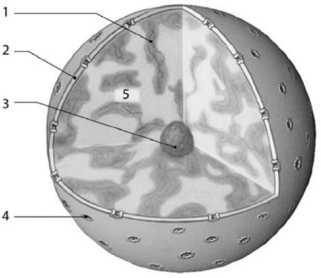 Figure 3-6 Nucleus
Figure 3-6 NucleusUse Figure 3-6 to answer the following question:
Identify the component of the nucleus in which rRNA synthesis and the assembly of ribosomal subunits occur.
A) 4
B) 3
C) 1
D) 5
E) 2

فتح الحزمة
افتح القفل للوصول البطاقات البالغ عددها 126 في هذه المجموعة.
فتح الحزمة
k this deck
67
The coils of nucleosomes found in non-dividing cells are called
A) nucleoplasms.
B) chromatin.
C) histones.
D) ribosomes.
E) nucleoli.
A) nucleoplasms.
B) chromatin.
C) histones.
D) ribosomes.
E) nucleoli.

فتح الحزمة
افتح القفل للوصول البطاقات البالغ عددها 126 في هذه المجموعة.
فتح الحزمة
k this deck
68
Peroxisomes are most closely related to
A) mitochondria.
B) nuclei.
C) nucleoli.
D) Golgi apparati.
E) lysosomes.
A) mitochondria.
B) nuclei.
C) nucleoli.
D) Golgi apparati.
E) lysosomes.

فتح الحزمة
افتح القفل للوصول البطاقات البالغ عددها 126 في هذه المجموعة.
فتح الحزمة
k this deck
69
Synthesis of phospholipids is a function of the
A) ribosomes.
B) Golgi apparatus.
C) lysosomes.
D) mitochondria.
E) smooth endoplasmic reticulum.
A) ribosomes.
B) Golgi apparatus.
C) lysosomes.
D) mitochondria.
E) smooth endoplasmic reticulum.

فتح الحزمة
افتح القفل للوصول البطاقات البالغ عددها 126 في هذه المجموعة.
فتح الحزمة
k this deck
70
The single structure that allows locomotion in some cells is the
A) histone.
B) cilium.
C) microfilament.
D) flagellum.
E) intermediate filament.
A) histone.
B) cilium.
C) microfilament.
D) flagellum.
E) intermediate filament.

فتح الحزمة
افتح القفل للوصول البطاقات البالغ عددها 126 في هذه المجموعة.
فتح الحزمة
k this deck
71
The cellular organelle responsible for removing and recycling damaged or denatured proteins is called the
A) mitochondrion.
B) nucleus.
C) nucleolus.
D) Golgi apparatus.
E) proteasome.
A) mitochondrion.
B) nucleus.
C) nucleolus.
D) Golgi apparatus.
E) proteasome.

فتح الحزمة
افتح القفل للوصول البطاقات البالغ عددها 126 في هذه المجموعة.
فتح الحزمة
k this deck
72
Which of the following contains an unusual double membrane?
A) mitochondrion
B) nucleolus
C) Golgi apparatus
D) peroxisome
E) lysosome
A) mitochondrion
B) nucleolus
C) Golgi apparatus
D) peroxisome
E) lysosome

فتح الحزمة
افتح القفل للوصول البطاقات البالغ عددها 126 في هذه المجموعة.
فتح الحزمة
k this deck
73
Examination of a sample of cells reveals large numbers of mitochondria compared to most other cells.Which of the following is a likely reason for this?
A) The cells produce digestive enzymes.
B) The cells produce steroid hormones.
C) The cells have very high energy requirements.
D) The cells synthesize transport proteins.
E) The cells make antibodies.
A) The cells produce digestive enzymes.
B) The cells produce steroid hormones.
C) The cells have very high energy requirements.
D) The cells synthesize transport proteins.
E) The cells make antibodies.

فتح الحزمة
افتح القفل للوصول البطاقات البالغ عددها 126 في هذه المجموعة.
فتح الحزمة
k this deck
74
Loosely coiled nucleosomes are known as
A) lysosomes.
B) nucleoli.
C) chromatin.
D) the nuclear envelope.
E) histones.
A) lysosomes.
B) nucleoli.
C) chromatin.
D) the nuclear envelope.
E) histones.

فتح الحزمة
افتح القفل للوصول البطاقات البالغ عددها 126 في هذه المجموعة.
فتح الحزمة
k this deck
75
When activated,lysosomes may function in
A) the formation of new cell membranes.
B) the synthesis of proteins.
C) autolysis.
D) the synthesis of lipids.
E) cell division.
A) the formation of new cell membranes.
B) the synthesis of proteins.
C) autolysis.
D) the synthesis of lipids.
E) cell division.

فتح الحزمة
افتح القفل للوصول البطاقات البالغ عددها 126 في هذه المجموعة.
فتح الحزمة
k this deck
76
When a protein is synthesized on fixed ribosomes,it is threaded into the lumen of which structure(s)?
A) endoplasmic reticulum
B) the Golgi apparatus
C) nucleoli
D) transport vesicles
E) secretory vesicles
A) endoplasmic reticulum
B) the Golgi apparatus
C) nucleoli
D) transport vesicles
E) secretory vesicles

فتح الحزمة
افتح القفل للوصول البطاقات البالغ عددها 126 في هذه المجموعة.
فتح الحزمة
k this deck
77
Microtubules
A) are usually composed of myosin.
B) are hollow, filamentous structures.
C) attach the plasma membrane to the underlying cytoplasm.
D) interact with filaments composed of tubulin to produce muscle contractions.
E) are found on the ribosomes.
A) are usually composed of myosin.
B) are hollow, filamentous structures.
C) attach the plasma membrane to the underlying cytoplasm.
D) interact with filaments composed of tubulin to produce muscle contractions.
E) are found on the ribosomes.

فتح الحزمة
افتح القفل للوصول البطاقات البالغ عددها 126 في هذه المجموعة.
فتح الحزمة
k this deck
78
Which structure leaves the nucleus during transcription of protein synthesis?
A) DNA
B) transport vesicle
C) centrioles
D) fixed ribosome
E) mRNA
A) DNA
B) transport vesicle
C) centrioles
D) fixed ribosome
E) mRNA

فتح الحزمة
افتح القفل للوصول البطاقات البالغ عددها 126 في هذه المجموعة.
فتح الحزمة
k this deck
79
The nucleus is surrounded by a double membrane called the
A) nucleolus.
B) plasma membrane.
C) nuclear pore.
D) cell wall.
E) nuclear envelope.
A) nucleolus.
B) plasma membrane.
C) nuclear pore.
D) cell wall.
E) nuclear envelope.

فتح الحزمة
افتح القفل للوصول البطاقات البالغ عددها 126 في هذه المجموعة.
فتح الحزمة
k this deck
80
 Figure 3-6 Nucleus
Figure 3-6 NucleusUse Figure 3-6 to answer the following question:
The cell's ribosomal RNA (rRNA)is produced by the
A) ribosomes.
B) nucleoli.
C) lysosomes.
D) smooth endoplasmic reticulum.
E) Golgi apparatus.

فتح الحزمة
افتح القفل للوصول البطاقات البالغ عددها 126 في هذه المجموعة.
فتح الحزمة
k this deck








